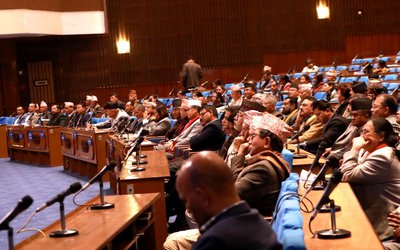Nepal's untiring efforts at bringing climate change adaptation activities into the field resulted on 9 August 2013 when the Ministry of Science, Technology and Environment (MoSTE) issued an authority for the implementation of the most prioritised urgent and immediate adaptation actions as included in the Local Adaptation Plan for Action (LAPA) of 69 VDCs and 1 municipality of mid- and far-west region. The MoSTE authorised the Local Development Officers (LDOs) of 14 districts to spend about NRs. 49 crores and 35 lakhs in this fiscal year for climate adaptation actions. The MoSTE and Nepal Climate Change Support Programme (NCCSP) organised an inception workshop at Nepalgunj on 8-9 August to brief the LDOs and programme officers of these districts on LAPA activities and implementation framework. These activities will be implemented by the DDCs to address the effects of climate change in selected rural and urban areas. Dr. Som Lal Subedi, the Secretary instructed LDOs to provide adaptation services to the needy people. This is the first project to implement adaptation options in the ground, based on NAPA. Its effective implementation will provide lessons on 'what worked and what did not', and provide guidance on future climate adaptation. The DFID and EU jointly provided £ 14.6 millionpre-funding support to the Government for the implementation of climate adaptation actions in these districts in the beginning of 2012. The Government with its 'service provider' took nearly one and a half year in preparatory phase. This period was longer than originally designed.
Nepal's climate change policy 2011 instructs authorities to allocate more than 80 percent of the total climate change fund for field level activities. Nepal is the only LDC which prepared the National Framework on LAPAs with support from DFID to implement climate adaptation activities as prioritised in the NAPA, endorsed by the Government on 28 September 2010. It required about three years to channelling fund and localising adaptation actions to address the adverse effects of, and adaptation to, climate change.
In Nepal, 1.9 million people are estimated climate change-wise most vulnerable, and additional 10 million are at risk of climate change. Nepal's economic growth rate, energy type and use pattern, and policies related to energy, forests, industry and climate change do not encourage greenhouse gas emissions. Hence, climate adaptation is a 'survival strategy' and 'development agenda' for Nepal.
Implementation of LAPA will address the needs of the local climate vulnerable communities, and will focus on women's empowerment, poor, disadvantaged and marginalised communities. The LAPA ensures gender inclusiveness and good governance, twin-track (bottom-up and top-down) approach and mainstreams adaptation actions into development planning from local to national levels.
During LAPA implementation in these 14 districts, over 50 per cent of the women are expected to benefit from LAPA generated employment opportunities; at least 55 per cent of the women will be engaged in implementing adaptation actions; and each user group and committee will be represented by over 50 per cent women. In other words, NCCSP has recognised poor and climate vulnerable groups, committed to build their capacity in order to address existing problems, and ensured for participation of women, dalit, most disadvantaged people and other beneficiaries by mainstreaming gender and social inclusion. This NCCSP is expected a corner stone to streamline climate change adaptation and NAPA implementation in Nepal as it focuses on process, establishes and strengthens institutions and funding mechanism to implement and promote scalable climate change adaptation and resilience measures.
Nepal has now realised the urgency of addressing climate change impacts. The Government has specified budget code for climate change and allocated about 10 per cent of its budget of this fiscal year on climate change-related activities. This is a good beginning to march towards our long destination of addressing the adverse effects of climate change to protect our people, property and ecosystem services from climate-induced disasters.
Nepal has additional opportunities for scaling-up climate adaptation actions in 2013 and 2014 being a Chair of the LDC Group for UN Framework Convention on Climate Change (UNFCCC). The NAPA experience calls for urgent action to start the formulation of National Adaptation Plan (NAP) process, to be an 'early mover', to address medium- and long-term adaptation needs. The UNEP and UNDP, with other partners have initiated Global Support Programme to assist LDCs in NAP formulation process. As of June 2013, 17 LDCs are already in pipeline for support.
The MoSTE as the focal point for UNFCCC is encouraged to start its process of accessing and securing climate finance from all available sources. There are high opportunities for scaled-up support on climate change through bilateral and multilateral sources including funds available from both within and outside the UNFCCC regime. Direct access on funding resources provides additional opportunities, and counts a lot for early implementation of response measures on climate change effects.

Batu Uprety
Former Joint-Secretary and Chief of Climate Change Management Division, Ministry of Environment (then), and former Team Leader, National Adaptation Plan (NAP) formulation process. E-mail: upretybk@gmail.com
- Sagarmatha Sambad: Likely Bearing the Fruits
- Mar 27, 2025
- Decadal Experience In Preparing The NDC
- Mar 03, 2025
- Over Five Decades Of Concern On Air Pollution
- Jan 16, 2025
- Damaging The Functional EIA Track
- Dec 22, 2024
- Baku CoP29 Outcomes And Nepal's Initiatives
- Nov 26, 2024














